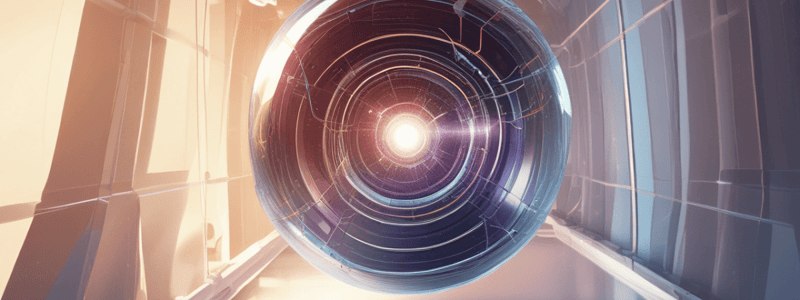Podcast
Questions and Answers
What makes a mirror different from a regular wall or surface?
What makes a mirror different from a regular wall or surface?
- The smoothness of its surface (correct)
- The material it is made of
- The way it absorbs light
- The color it reflects
Why does light bounce off a mirror in predictable ways?
Why does light bounce off a mirror in predictable ways?
- Because light is a particle
- Because the surface is smooth (correct)
- Because of the law of refraction
- Because of the law of reflection
What is the purpose of drawing light as a ray in ray tracing?
What is the purpose of drawing light as a ray in ray tracing?
- To illustrate the path of individual photons
- To simplify the illustration of light movement (correct)
- To demonstrate the law of reflection
- To show the wave-like properties of light
What happens to the peaks and valleys on a surface as it becomes smoother?
What happens to the peaks and valleys on a surface as it becomes smoother?
Why can't we see a clear image in a regular wall or dining room table?
Why can't we see a clear image in a regular wall or dining room table?
What is the law of reflection related to?
What is the law of reflection related to?
What is the principle behind the law of reflection?
What is the principle behind the law of reflection?
What is special about the surface of a mirror at the microscopic level?
What is special about the surface of a mirror at the microscopic level?
Why does a mirror produce an image, but a dining room table does not?
Why does a mirror produce an image, but a dining room table does not?
What is the term for when light bounces off in many directions?
What is the term for when light bounces off in many directions?
What is the purpose of a ray tracing diagram?
What is the purpose of a ray tracing diagram?
Why do parallel rays of light remain parallel after bouncing off a mirror?
Why do parallel rays of light remain parallel after bouncing off a mirror?
When you look at a mirror, where does the image appear to be?
When you look at a mirror, where does the image appear to be?
What is the angle of incidence equal to?
What is the angle of incidence equal to?
What is a characteristic of the way light rays behave when they hit a mirror?
What is a characteristic of the way light rays behave when they hit a mirror?
Flashcards are hidden until you start studying
Study Notes
What is a Mirror?
- A mirror is a reflective surface that shows a clear image
- Mirrors are super smooth surfaces, unlike regular surfaces like dining room tables which appear smooth on a large scale but have peaks and valleys when magnified
- The smoothness of a mirror allows light to bounce off it in predictable ways
Ray Tracing
- Ray tracing is a method of illustrating the path of light as a straight line coming from a source
- It helps to show how light moves in a particular situation
The Law of Reflection
- The law of reflection states that the angle light hits a surface (incident angle) is equal to the angle light bounces away from the surface (reflected angle)
- This law applies to all surfaces, including mirrors and irregular surfaces like dining room tables
- On irregular surfaces, light bounces off in many directions (diffuse reflection) due to peaks and valleys on the surface
How Mirrors Work
- A mirror's smooth surface allows parallel rays to follow the law of reflection and bounce off still parallel
- This results in the creation of an image
- When looking at a mirror, the image appears to be behind the mirror because light rays hit the body, bounce off the mirror, and then head back to the eyes
- Symmetrical light rays bounce off a mirror symmetrically, following the law of reflection
Studying That Suits You
Use AI to generate personalized quizzes and flashcards to suit your learning preferences.



